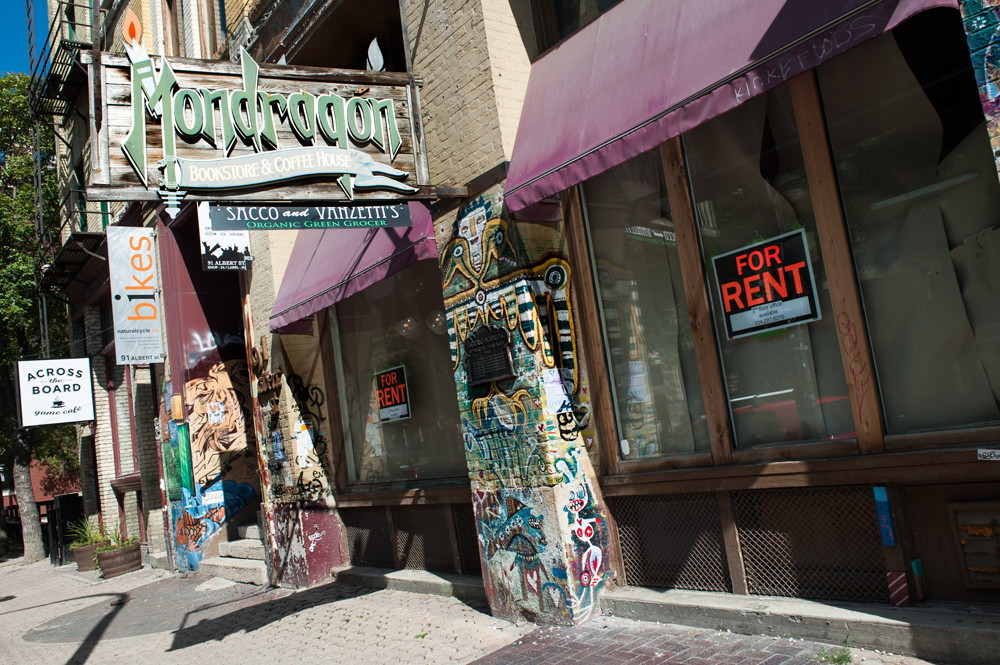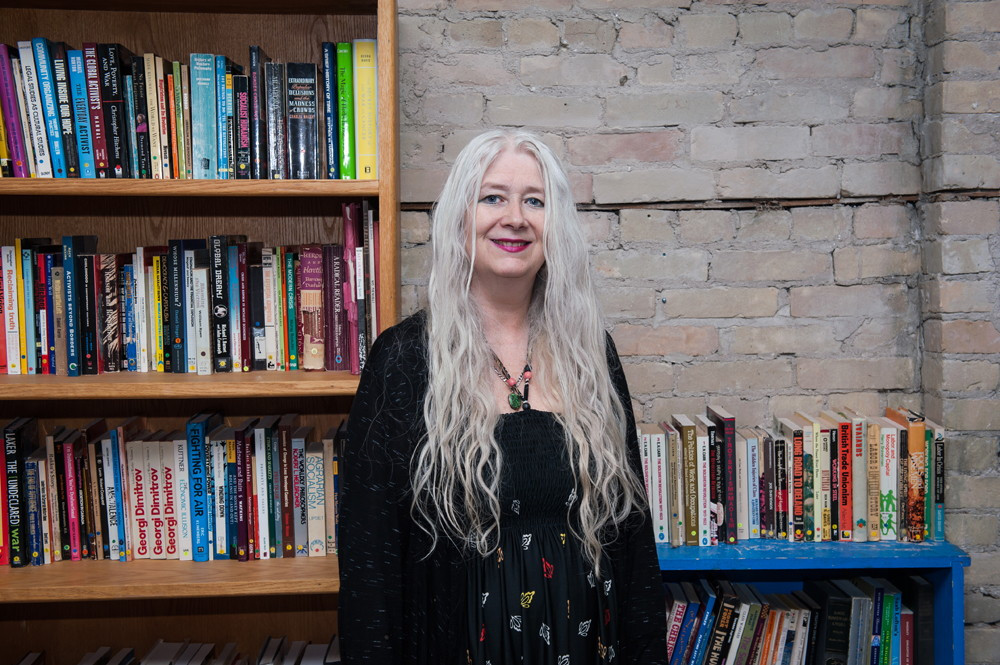Divided Dissent
Once-legendary anarchist scene in Winnipeg hitting barracades + reforming
Once upon a time, Winnipeg would’ve easily scored a top spot on the Top 10 Anarchist Hubs in North America listicle.
We’re not just talking a century ago either, although visits by Emma Goldman, Peter Kropotkin and Rudolf Rocker - the Holy Trinity of early 20th century anarchist theorists - certainly cemented that status. This history’s much more recent. As in 1995, when the Albert Street Autonomous Zone (A-Zone) was founded by Paul Burrows. Or in 2003, with the launch of the Organic Planet Worker Co-op in West Broadway. Think 2008, when the inaugural Winnipeg Anarchist Bookfair occupied the Old Market Square. But times have indeed changed.
“It does seem like the scene was more vibrant back then,” Tim Brandt says of the Bookfair, noting that the event’s organizing committee has been reduced to half the original size since its inception. “There may be a younger, different crowd coming up that I don’t know so much about, so I don’t want to be nostalgic. But it does seem a little looser or shrunken.”
The recent shuttering of Mondragon - the 18-year-old centrepiece of the A-Zone featuring a cafe, restaurant, bookstore and grocery mart - only underscores Brandt’s point. The closure has been discussed plenty. A full autopsy, worthy of many dozen pages, has yet to surface. But the last serving of Southern Fried Tofu has unquestionably made a mark in the local anarchist landscape; while the A-Zone - the most famous of Temporary Autonomous Zones (TAZ) in Canada - remains open, the main attraction is gone.
“ People need to put their energies into a place that inspires them and contributes in some way to a struggle or consciousness raising.
Paul Burrows, Albert St. Autonomous Zone founder
“I remember thinking when it opened, ‘fabulous idea, but how long will a business started by a bunch of left-wing radical people last? We better be there everyday before it falls apart. Because it’s going to be a couple of years, tops,’” says Susanne McCrea, founder of the Boreal Forest Network and long-time environmental activist. “And then it went for almost 20 years.”
The significance of such of a cessation is, of course, contentious; anarchism is an ideology united in opposition to authority, hierarchy and state, but that doesn’t mean it’s unanimous in any of the specifics. Strategy varies deeply. Take for example the writings of Murray Bookchin, the curmudgeonly American author who railed against the likes of Hakim Bey - the primary advocate for TAZs - because the concept favoured subcultural dissent (dumpster diving) over radical mass movements (overthrowing capitalism).
“It’s a very different thing to work in a worker-run small business than working in some kind of an organizing project that’s trying to build a movement,” explains David Camfield, the author of Canadian Labour in Crisis and one of the editors of the New Socialist Webzine. “That has a tendency to depoliticize a certain number of people; the focus is on keeping a struggling worker-run small business going.”
It’s a tense point, and certainly not just a difference of semantics. Camfield remembers that the venue served as a “local” for him, a place akin to a traditional pub in England where he could work and chat for hours. But he also makes it clear that he didn’t consider such interactions a political project. On the other hand, Burrows - a key founder of the A-Zone and Mondragon - contends that the common space connected a plethora of activists, many of whom would often go on to collaborate on other radical projects.

Mondragon Bookstore
“I’ve never been a big fan of either/or,” Burrows says. “People need to put their energies into a place that inspires them and contributes in some way to a struggle or consciousness raising. Beyond that, I’m not into telling people what to do. There was a moment there where that energy put into the A-Zone and Mondragon was more revitalizing and energizing for people than it became later on.”
John K. Samson - founder of Winnipeg band The Weakerthans and Arbeiter Ring Publishing (ARP) - was one of those people energized by Mondragon. He was in and around the building since the beginning, with ARP serving as one of the A-Zone’s first tenants and an apartment on Albert Street was his home for a few years in the late ‘90s. He’s adamant that Mondragon was a highly successful venue, noting that he meets radical activists all over the world who had either worked or visited the spot.
“One thing I think people overlook about Mondragon was the conviviality of cafe culture,” Samson says. “We’d all drink endless pots of coffee and talk, and that was important. Strip away all the activism framework about the way the place was run: it was a place for people to talk to each other.”

Susanne McCrea, founder of the Boreal Forest Network
The relationship that Mondragon had with the wider community was, as Burrows puts it, “ambiguous” and very dependent on the composition of the collective at the time. Sometimes Mondragon tended towards the welcoming side of the spectrum - representing optimism that people can indeed change when exposed to new perspectives - while at other moments it was staffed by “acerbic, hostile, judgmental folks who don’t want to be there giving you a latte, soy or otherwise.
“We have to aspire to a different kind of movement,” continues Burrows, who still holds parts of the mortgage on the building. “One that’s welcoming and recognizes where you yourself came from. You didn’t come out of the womb fully formed; you have to treat other people like they can always grow.”
That’s where Black Phoenix was intended to come in. Seven board members - including McCrea and Burrows - coalesced in May with the intent of eventually re-occupying Mondragon’s space with a similar model to the predecessor, putting an emphasis on a more hospitable, less polemical cafe environment. But that idea quickly faded. In mid-July, it was announced on Facebook that the business would “not be opening at 91 Albert.” McCrea asserts that “it isn’t dead, but is undergoing a rethink right now.”
Many other ideas abound for Mondragon’s replacement. Brandt advocates that the 10,998 sq. ft. A-Zone be sold and a smaller venue, such as a house be used as a more manageable substitute (the Junto Local 114 - a library of radical literature that Brandt’s a member of - recently moved from the second floor of the A-Zone to a house on Spence St.). Meanwhile, Camfield suggests that reading groups, public forums and new organizational initiatives are more important than a permanent space.
The debate will go on. But one thing’s for sure: many activists on the radical left no longer exclusively associate with anarchism (McCrea notes that she doesn’t know many active anarchists anymore, while Samson explains that he sees less value in ideological strictness these days). Of course, the key components of the tradition remain, but now they’re combining with others: anti-capitalists are partnering with Indigenous activists, who are finding allies in feminists and environmentalists. Perhaps there’s hope in that.
“The polarization has become very strong,” McCrea concludes. “People are really showing where they stand on issues these days. The Harper government is so ridiculous and the Indigenous people are becoming more vocal. People are choosing a side. Exposure is where those divides disappear. I’m really happy to say that now, if I go to a rally, I don’t necessarily know everybody.”
Published in Volume 69, Number 2 of The Uniter (September 10, 2014)







